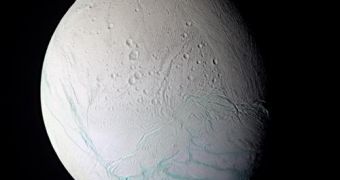While looking for evidence of life on other bodies in the solar system, researchers often evaluate the degree of habitability relying on the presence of water, sunlight, oxygen and so on. However, in the last decades, we came to learn that none of these three basic ingredients is absolutely required in order to sustain life. For example, on Earth, microbes may be found several kilometers underground, living without the need for oxygen or light, simply feeding with the energy released by chemical interactions or by radioactive decay in surrounding rocks.
This is what drives scientists to believe that life could be made possible on some of the moons in the solar system, such as Enceladus. On Earth, there are three ecosystems completely independent of photosynthesis; two of them are based on methanogens belonging to a group related to a bacteria called archae. While two of these ecosystems are powered by energy released from chemical interactions, the third is based on the energy given off by radioactive rocks.
The problem is that we have no idea how life came to be, nor if some of the theories related to the appearance of life are correct. At least two of the theories related to how life appeared on Earth do not seem to be compatible to the conditions on Enceladus, the 'primordial soup' theory and the deep sea vent theory.
In 1953, chemists Stanley L. Miller and Harold C. Urey experimented with a primordial soup made of chemicals present on Earth roughly at the time life first appeared. A mix of methane, ammonia, water vapor and hydrogen stimulated by an electrical spark formed, within two weeks, a soup of very complex molecules, namely amino-acids, the building blocks of basic proteins.
Although their prime objective did not include the creation of life, nor they succeeded, they have shown that life may have appeared spontaneously out of such a chemical mix. Alternatively, some of the ingredients required for the appearance of life may have been brought by comets, asteroids or even interplanetary dust.
The same organic molecules were the raw materials for the creation of moons such as Enceladus and many others. It has been proven that Enceladus is covered by a thick layer of water ice and the liquid water exists as well, although it is not clear yet what the source of the heat that turns water liquid is. It may even be possible that Enceladus is hiding an ocean of liquid water well below the surface. Originally, Enceladus would have been heated by the decay of radioactive rocks, process prolonged by the powerful tidal waves determined by the gravitational pull of Saturn.
Alternatively, heat could be generated through a process called serpentization, which means that water bonds with silicate rocks, thus increasing the volume of the rock in order to emit energy in the form of heat. All of the heating mechanisms may have been able to create the conditions suitable for a pre-biotic primordial soup.
The deep sea vent theory, on the other hand, implies that life began at the interface between chemically rich fluids, which were heated through one of the presented mechanisms. Hydrogen-sulfide and hydrogen emitted from a deep sea vent would act as a suitable reducer while carbon dioxide may carry the role of oxidant, in order to generate chemical energy. On Enceladus, identifying such locations would be a simple matter of finding hot spots of the sea floor.
However, even if these processes would be available for Enceladus, how long they would take before life appears is unknown. For all we know, on Earth the process was rather fast, but on Enceladus it might have started only several tens of millions of years ago. For life to continue to live and evolve, at least two conditions must be satisfied: liquid water and nutrients to be present. Both were found on Saturn's moon. Whether life exists on Enceladus, it may be revealed during further fly-bys through its watery plume, required to establish the organic compounds present inside it.

 14 DAY TRIAL //
14 DAY TRIAL //